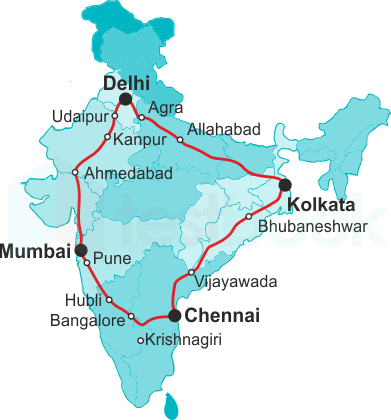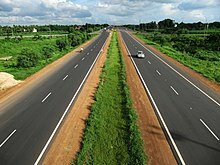
Economics Project On Golden Quadrilateral For Class 12
Introduction
The massive highway system known as the Golden Quadrilateral links India’s four major cities: Delhi, Mumbai, Chennai, and Kolkata. Atal Bihari Vajpayee, India’s then-prime minister, first conceived of the project in 1999; it was finished in 2012. One of the greatest highway construction projects in the world, it involves building 5,846 km of four to six-lane roadways. Travel times have decreased and the nation’s connectivity has considerably increased because to the Golden Quadrilateral, which has also boosted economic growth. The undertaking is seen by many as a significant infrastructural turning point for India.

Planning
Under the direction of Atal Bihari Vajpayee, who was India’s prime minister at the time, preparations for the Golden Quadrilateral started in 1999. In order to improve transportation and spur economic growth, the project sought to build a high-speed, four to six-lane highway network connecting India’s four largest cities.
The project was broken up into six phases, each of which focused on a separate network segment. The Delhi-Jaipur-Agra stretch was covered in the first phase, the Agra-Mumbai stretch in the second, the Chennai-Vijayawada stretch in the third, the Vijayawada-Kolkata stretch in the fourth, and the Chennai-Salem section in the fifth. In order to meet the requirements of the Golden Quadrilateral, existing roadways had to be upgraded and expanded in the project’s final stage.
Significant planning and coordination among numerous government agencies, private contractors, and stakeholders were required for the project. In-depth surveys and analyses were conducted as part of the planning process to choose the roadways’ most effective path, taking into account the terrain, existing infrastructure, and environmental impact. Numerous obstacles, including those related to funding, technical difficulties, and land acquisition, were encountered, but they were ultimately resolved in order to finish the project on time.
Network
The 5,846 km-long Golden Quadrilateral is home to a massive roadway system. It links India’s four largest metropolises—Delhi, Mumbai, Chennai, and Kolkata—and travels through 13 states, traversing a variety of topographical regions.
The network is made up of four- to six-lane highways that include numerous interchanges and access connections to neighbouring cities and towns. The highways offer a safe and effective mode of transportation while being able to handle heavy traffic.
To get around the obstacles that India’s varied geography naturally presents, the project also called for the construction of a number of new bridges, flyovers, and tunnels. In addition to enhancing connection between cities, these new infrastructural components have also created new economic prospects in hitherto unreachable places.
Travel time between the four major cities has been drastically shortened because to the Golden Quadrilateral, making it possible to go from one end of the country to the other in just a few days. The network has also helped the logistics and transportation sectors, which has improved the flow of commodities and goods across the nation.
Economics
Since its completion in 2012, the Golden Quadrilateral has had a significant impact on the Indian economy. As a result of the network’s enhanced connection and mobility, trade and commerce have risen, creating new economic opportunities and fostering regional growth.
The logistics and transport sectors have profited directly from the project due to the shortened travel distances and enhanced infrastructure. Additionally, new manufacturing and industrial hubs have emerged as a result of the highway network, particularly in the states that have direct access to it.
The tourism industry has benefited from better transportation, which has made it simpler for both domestic and foreign visitors to move throughout the nation. The expansion of new service industries including hotels, catering, and transportation has also been aided by the network.
Indirect effects of the Golden Quadrilateral on the economy include lower transportation costs, better supply chain management, and lower costs for inventories. Numerous economic sectors, such as manufacturing, retail, and agriculture, have grown as a result of these factors.
Overall, the Indian economy has benefited from the Golden Quadrilateral, which has significantly accelerated regional growth, connectivity, and infrastructure growth.
Social
The social structure of India has been significantly impacted by the Golden Quadrilateral. People may now travel between cities and regions more easily because to increased transport and connection, encouraging cultural interchange and generating new opportunities for employment and education.
The network has helped small and medium-sized businesses expand by presenting chances for entrepreneurship and local development. Particularly in the states that are directly connected to the network, this has resulted in the expansion of new businesses and the creation of new job prospects.
New urban centres and satellite towns have also been created as a result of the highway system, bringing infrastructure and housing to previously underserved areas. The development of new social and cultural institutions including schools, hospitals, and community centres has also resulted, enhancing the general standard of living for residents in these places.
The Golden Quadrilateral has also helped to boost tourism by giving people the chance to go to new areas of the nation and encounter other cultures. This has enhanced understanding of India’s rich cultural legacy and encouraged cross-cultural dialogue and understanding.
Overall, the Golden Quadrilateral has made a substantial contribution to India’s social development by opening up new avenues for employment, education, and cross-cultural interaction, as well as by fostering the establishment of new urban centres and social organisations.
Environment
The Golden Quadrilateral’s construction has affected the environment in both beneficial and negative ways. Because of the network, transit time and expenses have decreased, which has decreased air pollution and carbon emissions. The increased connectedness has also resulted in fewer vehicles on smaller routes, which has reduced traffic congestion and the resulting pollution.
However, the development of the highways has also had detrimental effects on the environment, particularly while it was being built. Large quantities of resources, including concrete, steel, and asphalt, had to be mined and transported over great distances in order to build the motorways. In the impacted areas, this resulted in soil erosion, deforestation, and biodiversity loss.
Communities residing in the impacted areas were uprooted as a result of the highway building, losing their traditional means of subsistence and cultural legacy. A decrease in biodiversity has been attributed to the loss of agricultural land and forest cover as a result of the establishment of new urban centres and satellite towns.
Several actions have been taken, such as the planting of new trees, the development of eco-friendly rest areas, and the creation of green belts along the highways, to lessen the negative effects of the Golden Quadrilateral on the environment. The project has also sparked the creation of brand-new, environmentally friendly transit systems, such hybrid buses and electric cars, which have reduced emissions and enhanced air quality.
Overall, the building of the Golden Quadrilateral has affected the environment in both beneficial and bad ways, and actions are being taken to lessen the latter and encourage sustainable growth.
Future
India’s economy, society, and ecology have already been significantly impacted by the Golden Quadrilateral. There are numerous prospects for network growth and development, nevertheless, as India develops and expands.
The integration of the Golden Quadrilateral with other transport networks, such as the railway system and the ports, is one potential area for future growth. This would enable the flow of people and goods across the nation and increase the efficiency and connectedness of the transportation system.
The adoption of new technology, such as electric automobiles, intelligent transportation systems, and smart highways, is another area for future development. These innovations might contribute to further lowering emissions and enhancing the transportation system’s overall sustainability.
For the existing highways to continue to be safe and effective in the future, there is also a need for ongoing investment in their maintenance and upkeep. Additionally, actions like reforestation, biodiversity preservation, and pollution reduction must be taken in order to lessen the network’s harmful effects on the environment.
The Golden Quadrilateral has been a great accomplishment for India overall and offers a solid framework for future expansion and development. The network has the potential to grow even more effective, sustainable, and advantageous for India’s population and economy with sustained investment and innovation.
Case Study

Mumbai-Pune Motorway: The Mumbai-Pune Motorway is a six-lane roadway that links Pune, a significant industrial center, with Mumbai, the financial capital of India. The motorway has helped to boost economic growth in the area by cutting the travel time between the two cities from five hours to two hours. In addition to enhancing traffic safety, the motorway has far fewer accidents and fatalities than the old route.
Motorway between Chennai and Bangalore: The Chennai-Bangalore Motorway is a four-lane road that connects these two southern cities. The motorway has facilitated the flow of people and products and boosted communication between the two cities. additional urban centres and satellite towns have also been created as a result, offering those who live in previously underserved areas additional housing and infrastructure.
Kolkata-Delhi Motorway: The six-lane highway that connects Kolkata and Delhi is known as the Kolkata-Delhi Motorway. The motorway is now being built, and it should be finished by 2025. Particularly in the states of Uttar Pradesh and Bihar, which are currently underserved by transport infrastructure, the project is anticipated to spur economic growth in the area. Additionally, the project is anticipated to increase connectivity between India’s eastern and northern regions.
Delhi-Mumbai Motorway: A projected eight-lane roadway that would link Delhi and Mumbai is known as the Delhi-Mumbai Motorway. By the time it is finished in 2024, the project should have greatly decreased the amount of time needed to travel between the two cities. Additionally, the project is anticipated to spur economic development in the area, particularly in the states of Gujarat and Rajasthan, which lack adequate transportation infrastructure at the moment.
These case studies demonstrate the considerable influence the Golden Quadrilateral has had on India’s social development, economic expansion, and transportation network. It is anticipated that the network’s continuous growth and development will benefit India’s population and economy even more.
Criticism
Some of the main criticisms include:
Displacement of People: People who lived in the areas where the highways were built have been displaced as a result of the highway construction. These people frequently lose their homes, land, and means of subsistence as a result of this.
Environmental Impact: Deforestation, soil erosion, air pollution, and water contamination are only a few of the environmental effects of highway development and use.
Uneven Growth: The advantages of the Golden Quadrilateral have not been distributed equally across the nation. Regional imbalances and inequalities have resulted from certain regions’ faster economic growth than others, especially those that are already developed.
Safety Concerns: Highway safety is still a concern, especially in locations with heavy traffic, despite the fact that the Golden Quadrilateral has improved road safety in many areas.
Financing: The project’s financing has also drawn criticism, with some people claiming that the government might have utilised the funds more wisely to deal with other urgent social and economic problems.
These concerns serve as a reminder of the importance of meticulous planning and management for infrastructure projects like the Golden Quadrilateral in order to maximise benefits and reduce adverse effects on people and the environment.
Conclusion
One of the largest infrastructure projects in Indian history, the Golden Quadrilateral has had a tremendous impact on the nation’s transportation system, economic expansion, and social development. The project has shortened travel times, stimulated economic growth, and improved access to essential services and opportunities for people in previously underserved regions by linking important cities and economic hubs throughout India.
The Golden Quadrilateral has, however, also faced criticism and difficulties, including the displacement of people, environmental effects, uneven development, safety concerns, and financial issues, just like any significant infrastructure project.
Overall, the Golden Quadrilateral is a significant breakthrough for India’s infrastructure, but there is still work to be done to address the issues and guarantee that the advantages are shared more fairly throughout the nation. Maximising the positive effects and reducing the negative effects of this significant initiative will require careful planning, management, and network extension and development.
Bibliography
Ministry of Road Transport and Highways. (2021). Golden Quadrilateral. Retrieved from https://morth.nic.in/golden-quadrilateral
Certificate
Date: [Insert Date]
I, [Student’s Name], a student of Class 12 at [School/College Name], am delighted to present my Economics project on the “Golden Quadrilateral. ” This project explores the significant highway system that connects India’s four major cities: Delhi, Mumbai, Chennai, and Kolkata. Through extensive research and analysis, I have gained a deeper understanding of the project’s planning, economic impact, social implications, environmental effects, and future prospects.
Undertaking this project has been a remarkable learning experience for me. I had the opportunity to explore the visionary leadership of former Prime Minister Atal Bihari Vajpayee, whose initiative in 1999 led to the conception of the Golden Quadrilateral. The planning process, involving multiple government agencies, private contractors, and stakeholders, impressed upon me the importance of coordination and meticulous decision-making in large-scale infrastructure projects.
Learning about the vast network of four to six-lane highways spanning 5, 846 km, traversing diverse topographical regions, and connecting 13 states was truly fascinating. I discovered how this well-constructed network has significantly reduced travel times between major cities, leading to enhanced trade, commerce, and economic growth.
The impact of the Golden Quadrilateral on various sectors, such as logistics, transportation, tourism, and manufacturing, has been eye-opening. It has not only facilitated the movement of goods and people but also encouraged entrepreneurship and local development in previously underserved areas.
Addressing the environmental aspects of the project made me aware of both its positive and negative effects. While the reduced travel distances have led to decreased air pollution and carbon emissions, I also learned about the challenges related to deforestation, soil erosion, and biodiversity loss during the construction phase. It highlighted the importance of sustainable practices in infrastructure development.
Through this project, I have gained a better understanding of the Golden Quadrilateral’s role in fostering regional growth, social development, and cultural exchange. I have also acknowledged the criticisms surrounding displacement, uneven growth, and safety concerns associated with such projects.
As I conclude my project, I believe that the Golden Quadrilateral stands as a testament to India’s infrastructure development, but also reminds us of the need for inclusive and environmentally conscious planning. I am hopeful that with continued investment and innovation, the network’s future growth will further benefit India’s population and economy.
I extend my heartfelt gratitude to my Economics teacher for guiding and supporting me throughout this project. I also thank the school administration for providing me with this valuable opportunity to delve into such a significant aspect of India’s development.
[Student’s Name] [Class 12] [School/College Name]In order to download the PDF, You must follow on Youtube. Once done, Click on Submit
Follow On YoutubeSubscribed? Click on Confirm
Download Economics Project On Golden Quadrilateral For Class 12 PDF






